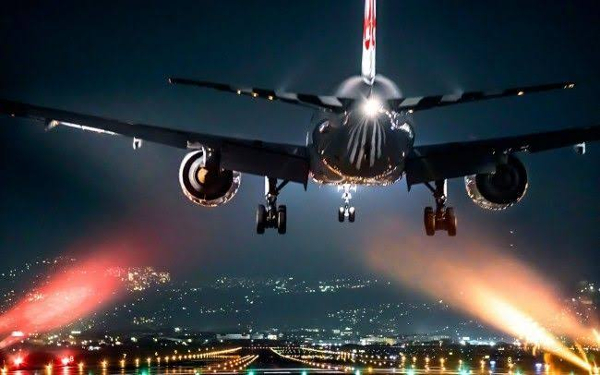How many times have you taken a flight at midnight or even at 3 am, spent the rest of the night sitting uncomfortably in an economy class seat, and reached your destination bleary eyed and sleep deprived? And what about those living close to airports in metros, who complain that the noise from aircraft that are taking off and landing in the middle of the night disturbs their sleep, and more importantly causes noise pollution?
Well, this happens because airports in India, like those in a host of other countries, including Singapore, Dubai and Colombo, operate their airports 24/7, 365 days a year.
However, there are also a handful of countries such as the US, Switzerland and Germany and some airports in Australia, that follow a night curfew — these airports are shut down for commercial operations between 11 pm and 5 am. For instance the Ronald Reagan airport in Washington imposes a night curfew between 10 pm and 6.58 am. During this time, these airports only allow emergency flights to land and take off.
Night curfew
These countries have been following night curfews since the 1960s, when aircraft engines were very noisy, and, according to the International Civil Aviation Organization (ICAO), the curfew was primarily a result of local protests about noise pollution at night.
Speaking to BusinessLine, the late Maurice Flanagan, the man who set up the Dubai-based Emirates Airlines, once said: “The best way to find out if a man has really worked in the airline industry is to check if he is deaf or not. A true airline industry person would have worked around aircraft that made so much noise that everyone around them was stone deaf.” He apologised profusely for asking the same question be repeated over and over again loudly so that he could hear. Flanagan had worked at British airports in the 1960s.
However, a lot has changed since then. Firstly, aircraft are a lot quieter today — they are 75 per cent quieter than they were 40 years ago. Further, airports and airlines have changed the landing procedures to ensure less noise.
Another thing that has changed in India’s context is that the aviation industry has grown dramatically during this period. India has now become the third-largest domestic civil aviation market globally. Domestic airlines are adding more planes with the number expected to reach 1,000 in the next few years.
When India was turned down
In this context, India and a few countries felt that the night curfew imposed by some airports was not allowing it a level playing field. It approached the ICAO in 2007 seeking a more equitable system as night curfew was having a negative impact on Indian aviation’s growth. India pointed out that the unilateral imposition of night curfew by a few countries was leading to congestion on air routes and airports and under-utilisation of aviation infrastructure at destination airports in India.
India also argued that the imposition of night curfew at some European airports had led to the transfer of their night time noise burden to developing countries, where night-time noise was generated by aircraft scheduled to avoid departing or arriving during the curfew period at European airports.
It further pointed out that night curfew restricted airlines’ capabilities to offer flights at convenient arrival and departure times, reducing customer choice and affecting airlines’ level of service.
The ICAO, however, did not accept the proposal that India and a few other countries made.
Infrastructure still catching up
However, what also cannot be ignored is that while Indian aviation has grown dramatically, airport infrastructure, essential for airline operations, has not kept pace. Currently, seven airports account for over 75 per cent of the passengers carried by domestic airlines, with the metros seeing the maximum movement of passengers.
Further, private airlines in India now offer late-night Red Eye flights — globally flights that operate between 11 pm and 5 am are called Red Eye flights. Among the many advantages of Red Eye flights are the fact that fares on these are much lower than day flights and they give flyers the option of getting a full day both in their home city and in the destination city. These same reasons also hold for domestic Indian Red Eye flights.
Even international airlines that operate multiple daily flights from India offer fares that are marginally lower on flights departing at night as compared to those departing in the day.
Not an alien concept
Incidentally, operating late-night flights is not a new concept in India. It started with a low-fare, late-night flight between Delhi and Mumbai and Delhi and Bangalore by Vayudoot in the late 1980s and early 1990s. The airline, which was later merged with Indian Airlines, leased a Boeing 757 from the Royal Nepal Air Corporation (RNAC), which was parked at night in Delhi, to launch late-night flights connecting the national capital to Mumbai and Bangalore. The aircraft returned to Delhi in the morning and RNAC operated its scheduled service between Delhi and Kathmandu.
This late-night connection was a boon for travellers in those days as Indian Airlines was the only airline flying within the country. It operated a limited number of flights, offering limited choice. The Vayudoot alternative allowed passengers to re-plan their day’s activity and fly for less. It was a better alternative than a train journey that would involve travel of up to a day, one way, between Delhi and Mumbai.
With more airlines and better air connectivity this flexibility of finding appropriate and possibly cheaper fares has only improved.
Source: THBL
You may also like
-
Trade Connect E-platform For Exports Is Single Window, Fast, Accessible And Transformational: Shri Piyush Goyal
-
Dot Simplifies Approval Processes For Telecom Licenses And Wireless Equipment
-
Coal Production and Supply Trends on Positive Trajectory
-
Union Minister To Release Booklets On Promotion Of Indigenous Species & Conservation Of States Fishes
-
2nd India-Japan Finance Dialogue held in Tokyo on 6th September, 2024
